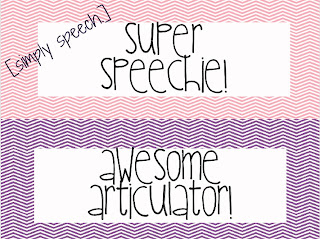Good morning! Yesterday I posted a book review on Speaking of Apraxia by Leslie Lindsay. (If you missed it, make sure you check it out) I am so excited to have a guest post written by her today! Without any further delay, take it away Leslie....
Reading Green Eggs and Ham with Apraxia
By Leslie Lindsay
I don’t know about you, but I love
books. I love kids. And when one combines the love for children
and literature, what often results is the abundance of words. And perhaps the
proud moment of announcing, “Hey—she can read!” a year of two ahead of
schedule.
But not if you have a child with
apraxia.*
At two years old, our daughter Kate was
a beautiful, energetic, and happy toddler. With the exception of one
word—hi—Kate was as quiet as a mouse. We wondered if something was wrong. Even
as a baby, Kate rarely babbled and cried; she was beautiful and unique with red
hair and bright blue eyes. She was, in a
word, “perfect.” So why were we worried? After all, she could understand everything we said, even the
big words. And what was so wrong with
having a quiet, happy toddler?
And so we read. As parents we read parenting books about late-talking children. We read about speech development and ways to
stimulate our child. We read books to Kate.
Simple board books by Dr. Seuss and Sandra Boynton that had the happy
cadence of alliteration and rhyme. We
pointed out illustrations in the book, “Oh, look-y here…can you see the
birdie? Can you say bird?” We engaged in dialogic reading with our
daughter, “What do think will happen next?”
And nothing.
Sure, she understood everything we
said, even the hard words. We could tell
because she would be able to perform simple directions like, “go get your
shoes, we’re going for a walk.” But
still, nothing. At least not any expressive
language.
Kate was diagnosed with childhood
apraxia of speech (CAS), a neurologically- based motor speech disorder in which
kids know what they want to say, yet they can’t coordinate the complex
movements required to speak intelligibly. She was 2 ½ years old. What resulted instead was a lot of pointing
and gibberish.
Fast-forward five years, and you will
see that Kate has overcome a considerable challenge. She is now a normally-speaking soon-to-be 2nd
grader. Sure, there were struggles and
years of speech therapy.
Our speech-language pathologist (SLP),
mentioned that children with CAS have a particularly difficult time with
identifying and composing rhymes. Why
exactly this is, is speculative. Some
say it has to do with the overall motor circulatory of the brain, the “wiring,”
if you will; or the abstract arrangement of sounds and letters, perhaps it’s the
mind-body connection, or simply being a visual versus auditory learner…in any
case, it’s a challenge.
But just this past week, we pulled out
Dr. Seuss’s Green Eggs and Ham. My husband handed the shiny orange book to
Kate at bedtime,** “Here, you read this one.”
She looked at her daddy with wide eyes, “You can do it,” he coaxed.
She sucked in a deep breath and rolled
her lips into a tight line, “I am Sam,” she began.
My eyes welled with tears. Her voice a little choppy (prosody is
something she will likely always struggle with), a few stumbles here and there,
and a long pause about half-way through, I cheered her on in my mind. Finally, she sighed, “I can’t do it
anymore.” We egged her on (sorry,
couldn’t resist), “Yes. You can do
this.” (We ended up alternating
pages. Reading aloud can be very taxing
for children with apraxia).
And you know what? She read that whole book. Say, I do like reading and rhyming, Kate-I-am. (*Commonly known as Childhood Apraxia of
Speech (CAS), or “dyspraxia of speech” in the U.K. and elsewhere. **In retrospect, it would have been best to
have Kate attempt a challenging rhyming book at a time of day when she is
likely to be more alert).
Try
it at home:
·
Remember, you are your child’s
cheerleader. Let them know you care and support them, but
don’t make it too easy. Challenging your
children to the point of feeling slightly uncomfortable is okay. It means they are growing (and you are, too)
·
Get yourself to the library. Ask a children’s librarian for some simple
rhyming books. Even if they seem a
little “baby-ish,” read them to and with your child with apraxia. Practice, practice, practice! (Some titles to look for, There’s a Closet in My Woset by Dr.
Seuss, ‘Twas the Night Before
Kindergarten (1st grade edition also available) by Natasha Wing,
BOB books).
·
Remember, there is a difference
between rhyming books (cat and mat) and
predictable/repetitive books (it’s
pretty clear that you know what will happen next; the same phrase pops up every
few lines (Goodnight Moon by Margaret
Wise Brown) and wordless books
(there is no text; you and your child create your own story as you study the
illustrations; Good Dog, Carl by Alexandra Day) and cause and effect books (If
You Give a…. series by Laura Numeroff) All types of books are important to
a child with CAS.
·
Extend your reading activity to
make it whole-body experience. Act it out (as in charades),
whip up a batch of green eggs and ham or some chocolate chip cookies. Have your child draw a picture or make her
own “book” related to what you just read.
Bio: Leslie Lindsay is former child/adolescent psych R.N. at the Mayo
Clinic-Rochester. She is the mother of two school-aged daughters and a basset
hound, named Sally. Lindsay and her family reside in the Chicago suburbs where
she writes full-time. She is the author of “Speaking of Apraxia: A
Parents’ Guide to Childhood Apraxia of Speech” (Woodbine House,
March 2012). Read more on her blog, “Practical Parenting…with a Twist” where she writes about
apraxia, parenting, education, and more 5 days a week, www.leslie4kids.wordpress.com












































